Manifestation of the Purcell Effect in Current Transport through a Dot–Cavity–QED System
Abstract
1. Introduction
2. Hamiltonian of the Total System
3. Results
4. Summary
Author Contributions
Funding
Acknowledgments
Conflicts of Interest
Abbreviations
| QD | Quantum Dot |
| Temperature of the left lead | |
| Temperature of the right lead | |
| MB | Many-Body states |
| 0 | Ground-state energy |
| 10 | one-photon replica of the ground-state |
| 20 | two-photon replica of the ground-state |
| 1st | first-excited state |
| 11st | one-photon replica of the first-excited state |
| 2nd | second-excited state |
| 3rd | third-excited state |
| 4th | fourth-excited state |
| 5th | fifth-excited state |
| 6th | sixth-excited state |
References
- Imamoglu, A.; Yamamoto, Y. Turnstile device for heralded single photons: Coulomb blockade of electron and hole tunneling in quantum confined p -i- n heterojunctions. Phys. Rev. Lett. 1994, 72, 210–213. [Google Scholar] [CrossRef] [PubMed]
- Giannelli, L.; Schmit, T.; Calarco, T.; Koch, C.P.; Ritter, S.; Morigi, G. Optimal storage of a single photon by a single intra-cavity atom. New J. Phys. 2018, 20, 105009. [Google Scholar] [CrossRef]
- Aspuru-Guzik, A.; Walther, P. Photonic quantum simulators. Nat. Phys. 2012, 8, 285. [Google Scholar] [CrossRef]
- Cialdi, S.; Rossi, M.A.C.; Benedetti, C.; Vacchini, B.; Tamascelli, D.; Olivares, S.; Paris, M.G.A. All-optical quantum simulator of qubit noisy channels. Appl. Phys. Lett. 2017, 110, 081107. [Google Scholar] [CrossRef]
- Lin, Q.; He, B. Highly Efficient Processing of Multi-photon States. Sci. Rep. 2015, 5, 12792. [Google Scholar] [CrossRef] [PubMed][Green Version]
- Hanschke, L.; Fischer, K.A.; Appel, S.; Lukin, D.; Wierzbowski, J.; Sun, S.; Trivedi, R.; Vuckovic, J.; Finley, J.J.; Müller, K. Quantum dot single-photon sources with ultra-low multi-photon probability. NPJ Quantum Inf. 2018, 4, 43. [Google Scholar] [CrossRef]
- Kreinberg, S.; Grbesic, T.; Strauß, M.; Carmele, A.; Emmerling, M.; Schneider, C.; Höfling, S.; Porte, X.; Reitzenstein, S. Quantum-optical spectroscopy of a two-level system using an electrically driven micropillar laser as a resonant excitation source. Light Sci. Appl. 2018, 7, 41. [Google Scholar] [CrossRef] [PubMed]
- Boehm, F. Nanomedical Device and Systems Design: Challenges, Possibilities, Visions, 1st ed.; CRC Press: Boca Raton, FL, USA, 2017. [Google Scholar]
- Ren, Q.; Lu, J.; Tan, H.H.; Wu, S.; Sun, L.; Zhou, W.; Xie, W.; Sun, Z.; Zhu, Y.; Jagadish, C.; et al. Spin-Resolved Purcell Effect in a Quantum Dot Microcavity System. Nano Lett. 2012, 12, 3455–3459. [Google Scholar] [CrossRef] [PubMed]
- Gerardino, A.; Pettinari, G.; Caselli, N.; Vignolini, S.; Riboli, F.; Biccari, F.; Felici, M.; Polimeni, A.; Fiore, A.; Gurioli, M.; et al. Coupled Photonic Crystal Nanocavities as a Tool to Tailor and Control Photon Emission. Ceramics 2019, 2, 34–55. [Google Scholar] [CrossRef]
- Dorfman, K.E.; Mukamel, S. Multidimensional photon correlation spectroscopy of cavity polaritons. Proc. Natl. Acad. Sci. USA 2018, 115, 1451–1456. [Google Scholar] [CrossRef] [PubMed]
- Frisk Kockum, A.; Miranowicz, A.; De Liberato, S.; Savasta, S.; Nori, F. Ultrastrong coupling between light and matter. Nat. Rev. Phys. 2019, 1, 19–40. [Google Scholar] [CrossRef]
- De Greve, K.; Yu, L.; McMahon, P.L.; Pelc, J.S.; Natarajan, C.M.; Kim, N.Y.; Abe, E.; Maier, S.; Schneider, C.; Kamp, M.; et al. Quantum-dot spin-photon entanglement via frequency downconversion to telecom wavelength. Nature 2012, 491, 421. [Google Scholar] [CrossRef] [PubMed]
- Delbecq, M.R.; Bruhat, L.E.; Viennot, J.J.; Datta, S.; Cottet, A.; Kontos, T. Photon-mediated interaction between distant quantum dot circuits. Nat. Commun. 2013, 4, 1400. [Google Scholar] [CrossRef] [PubMed]
- Cottet, A.; Kontos, T.; Douçot, B. Electron–photon coupling in mesoscopic quantum electrodynamics. Phys. Rev. B 2015, 91, 205417. [Google Scholar] [CrossRef]
- Hümmer, T.; García-Vidal, F.J.; Martín-Moreno, L.; Zueco, D. Weak and strong coupling regimes in plasmonic QED. Phys. Rev. B 2013, 87, 115419. [Google Scholar] [CrossRef]
- Sánchez, R.; Platero, G.; Brandes, T. Resonance fluorescence in driven quantum dots: Electron and photon correlations. Phys. Rev. B 2008, 78, 125308. [Google Scholar] [CrossRef]
- Dewhurst, S.J.; Granados, D.; Ellis, D.J.P.; Bennett, A.J.; Patel, R.B.; Farrer, I.; Anderson, D.; Jones, G.A.C.; Ritchie, D.A.; Shields, A.J. Slow-light-enhanced single quantum dot emission in a unidirectional photonic crystal waveguide. Appl. Phys. Lett. 2010, 96, 031109. [Google Scholar] [CrossRef]
- del Valle, E.; Laussy, F. Effective cavity pumping from weakly coupled quantum dots. Superlattices Microstruct. 2011, 49, 241–245. [Google Scholar] [CrossRef][Green Version]
- Snijders, H.J.; Frey, J.A.; Norman, J.; Flayac, H.; Savona, V.; Gossard, A.C.; Bowers, J.E.; van Exter, M.P.; Bouwmeester, D.; Löffler, W. Observation of the Unconventional Photon Blockade. Phys. Rev. Lett. 2018, 121, 043601. [Google Scholar] [CrossRef]
- Leng, H.; Szychowski, B.; Daniel, M.C.; Pelton, M. Strong coupling and induced transparency at room temperature with single quantum dots and gap plasmons. Nat. Commun. 2018, 9, 4012. [Google Scholar] [CrossRef]
- Cirio, M.; De Liberato, S.; Lambert, N.; Nori, F. Ground State Electroluminescence. Phys. Rev. Lett. 2016, 116, 113601. [Google Scholar] [CrossRef] [PubMed]
- Gudmundsson, V.; Abdulla, N.R.; Sitek, A.; Goan, H.S.; Tang, C.S.; Manolescu, A. Electroluminescence Caused by the Transport of Interacting Electrons through Parallel Quantum Dots in a Photon Cavity. Annalen Physik 2018, 530, 1700334. [Google Scholar] [CrossRef]
- Eichler, C.; Lang, C.; Fink, J.M.; Govenius, J.; Filipp, S.; Wallraff, A. Observation of Entanglement between Itinerant Microwave Photons and a Superconducting Qubit. Phys. Rev. Lett. 2012, 109, 240501. [Google Scholar] [CrossRef] [PubMed]
- Lang, C.; Bozyigit, D.; Eichler, C.; Steffen, L.; Fink, J.M.; Abdumalikov, A.A.; Baur, M.; Filipp, S.; da Silva, M.P.; Blais, A.; et al. Observation of Resonant Photon Blockade at Microwave Frequencies Using Correlation Function Measurements. Phys. Rev. Lett. 2011, 106, 243601. [Google Scholar] [CrossRef] [PubMed]
- Faraon, A.; Fushman, I.; Englund, D.; Stoltz, N.; Petroff, P.; Vuckovic, J. Coherent generation of non-classical light on a chip via photon-induced tunnelling and blockade. Nat. Phys. 2008, 4, 859. [Google Scholar] [CrossRef]
- Gudmundsson, V.; Sitek, A.; Lin, P.y.; Abdullah, N.R.; Tang, C.S.; Manolescu, A. Coupled collective and Rabi oscillations triggered by electron transport through a photon cavity. ACS Photonics 2015, 2, 930. [Google Scholar] [CrossRef]
- Wu, Y.; Wang, Y.; Qin, X.; Rong, X.; Du, J. A programmable two-qubit solid-state quantum processor under ambient conditions. NPJ Quantum Inf. 2019, 5, 9. [Google Scholar] [CrossRef]
- Sillanpää, M.A.; Park, J.I.; Simmonds, R.W. Coherent quantum state storage and transfer between two phase qubits via a resonant cavity. Nature 2007, 449, 438. [Google Scholar] [CrossRef]
- Majer, J.; Chow, J.M.; Gambetta, J.M.; Koch, J.; Johnson, B.R.; Schreier, J.A.; Frunzio, L.; Schuster, D.I.; Houck, A.A.; Wallraff, A.; et al. Coupling superconducting qubits via a cavity bus. Nature 2007, 449, 443. [Google Scholar] [CrossRef] [PubMed]
- Purcell, E.M.; Torrey, H.C.; Pound, R.V. Resonance Absorption by Nuclear Magnetic Moments in a Solid. Phys. Rev. 1946, 69, 37–38. [Google Scholar] [CrossRef]
- Saatsakis, G.; Michail, C.; Fountzoula, C.; Kalyvas, N.; Bakas, A.; Ninos, K.; Fountos, G.; Sianoudis, I.; Kandarakis, I.; Panayiotakis, G.; et al. Fabrication and Luminescent Properties of Zn–Cu–In–S/ZnS Quantum Dot Films under UV Excitation. Appl. Sci. 2019, 9, 2367. [Google Scholar] [CrossRef]
- Kiraz, A.; Reese, C.; Gayral, B.; Zhang, L.; Schoenfeld, W.V.; Gerardot, B.D.; Petroff, P.M.; Hu, E.L.; Imamoglu, A. Cavity-quantum electrodynamics with quantum dots. J. Opt. B Quantum Semiclass. Opt. 2003, 5, 129–137. [Google Scholar] [CrossRef]
- Landi, M.; Zhao, J.; Prather, W.E.; Wu, Y.; Zhang, L. Acoustic Purcell Effect for Enhanced Emission. Phys. Rev. Lett. 2018, 120, 114301. [Google Scholar] [CrossRef] [PubMed]
- Wilk, T.; Webster, S.C.; Specht, H.P.; Rempe, G.; Kuhn, A. Polarization-Controlled Single Photons. Phys. Rev. Lett. 2007, 98, 063601. [Google Scholar] [CrossRef] [PubMed]
- Press, D.; Götzinger, S.; Reitzenstein, S.; Hofmann, C.; Löffler, A.; Kamp, M.; Forchel, A.; Yamamoto, Y. Photon Antibunching from a Single Quantum-Dot-Microcavity System in the Strong Coupling Regime. Phys. Rev. Lett. 2007, 98, 117402. [Google Scholar] [CrossRef] [PubMed]
- Zhang, Q.; Lou, M.; Li, X.; Reno, J.L.; Pan, W.; Watson, J.D.; Manfra, M.J.; Kono, J. Collective non-perturbative coupling of 2D electrons with high-quality-factor terahertz cavity–photons. Nat. Phys. 2016, 12, 1005. [Google Scholar] [CrossRef]
- Jonsson, T.H.; Manolescu, A.; Goan, H.S.; Abdullah, N.R.; Sitek, A.; Tang, C.S.; Gudmundsson, V. Efficient determination of the Markovian time-evolution towards a steady-state of a complex open quantum system. Comput. Phys. Commun. 2017, 220, 81–90. [Google Scholar] [CrossRef]
- Gudmundsson, V.; Gestsson, H.; Abdullah, N.R.; Tang, C.S.; Manolescu, A.; Moldoveanu, V. Coexisting spin and Rabi oscillations at intermediate time regimes in electron transport through a photon cavity. Beilstein J. Nanotechnol. 2019, 10, 606–616. [Google Scholar] [CrossRef]
- Abdullah, N.R.; Tang, C.S.; Manolescu, A.; Gudmundsson, V. Oscillations in electron transport caused by multiple resonances in a quantum dot-QED system in the steady-state regime. arXiv 2019, arXiv:1903.03655. [Google Scholar]
- Abdullah, N.R.; Tang, C.S.; Manolescu, A.; Gudmundsson, V. Delocalization of electrons by cavity photons in transport through a quantum dot molecule. Physica E 2014, 64, 254–262. [Google Scholar] [CrossRef]
- Abdullah, N.R.; Tang, C.S.; Manolescu, A.; Gudmundsson, V. Electron transport through a quantum dot assisted by cavity photons. J. Phys. Condens. Matter 2013, 25, 465302. [Google Scholar] [CrossRef] [PubMed]
- Abdullah, N.R.; Tang, C.S.; Manolescu, A.; Gudmundsson, V. Cavity-Photon Controlled Thermoelectric Transport through a Quantum Wire. ACS Photonics 2016, 3, 249–254. [Google Scholar] [CrossRef]
- Abdullah, N.R.; Tang, C.S.; Manolescu, A.; Gudmundsson, V. Coherent transient transport of interacting electrons through a quantum waveguide switch. J. Phys. Condens. Matter 2015, 27, 015301. [Google Scholar] [CrossRef] [PubMed]
- Gudmundsson, V.; Jonasson, O.; Tang, C.S.; Goan, H.S.; Manolescu, A. Time-dependent transport of electrons through a photon cavity. Phys. Rev. B 2012, 85, 075306. [Google Scholar] [CrossRef]
- Abdullah, N.R.; Tang, C.S.; Manolescu, A.; Gudmundsson, V. Spin-dependent heat and thermoelectric currents in a Rashba ring coupled to a photon cavity. Phys. E Low-Dimens. Syst. Nanostruct. 2017. [Google Scholar] [CrossRef]
- Abdullah, N.R.; Tang, C.S.; Manolescu, A.; Gudmundsson, V. The photocurrent generated by photon replica states of an off-resonantly coupled dot-cavity system. arXiv 2019, arXiv:1904.04888. [Google Scholar]
- Gudmundsson, V.; Jonasson, O.; Arnold, T.; Tang, C.S.; Goan, H.S.; Manolescu, A. Stepwise introduction of model complexity in a general master equation approach to time-dependent transport. Fortschr. Phys. 2013, 61, 305. [Google Scholar] [CrossRef]
- Gudmundsson, V.; Abdullah, N.R.; Sitek, A.; Goan, H.S.; Tang, C.S.; Manolescu, A. Current correlations for the transport of interacting electrons through parallel quantum dots in a photon cavity. Phys. Lett. A 2018, 382, 1672–1678. [Google Scholar] [CrossRef]
- Zwanzig, R. Ensemble Method in the Theory of Irreversibility. J. Chem. Phys. 1960, 33, 1338–1341. [Google Scholar] [CrossRef]
- Nakajima, S. On quantum theory of transport phenomena steady diffusion. Prog. Theor. Phys. 1958, 20, 948. [Google Scholar] [CrossRef]
- Lax, M. Formal Theory of Quantum Fluctuations from a Driven State. Phys. Rev. 1963, 129, 2342–2348. [Google Scholar] [CrossRef]
- Gardiner, C.W.; Collett, M.J. Input and output in damped quantum systems: Quantum stochastic differential equations and the master equation. Phys. Rev. A 1985, 31, 3761–3774. [Google Scholar] [CrossRef]
- Beaudoin, F.; Gambetta, J.M.; Blais, A. Dissipation and ultrastrong coupling in circuit QED. Phys. Rev. A 2011, 84, 043832. [Google Scholar] [CrossRef]
- Gudmundsson, V.; Sitek, A.; Abdullah, N.R.; Tang, C.S.; Manolescu, A. Cavity–photon contribution to the effective interaction of electrons in parallel quantum dots. Annalen Physik 2016, 528, 394–403. [Google Scholar] [CrossRef]
- Kim, N.C.; Ko, M.C. Switching of a Single Photon by Two Λ-Type Three-Level Quantum Dots Embedded in Cavities Coupling to One-Dimensional Waveguide. Plasmonics 2015, 10, 605–610. [Google Scholar] [CrossRef]
- Purcell, E.M. Spontaneous Emission Probabilities at Radio Frequencies. Phys. Rev. 1946, 69, 681. [Google Scholar] [CrossRef]
- Arnold, T.; Tang, C.S.; Manolescu, A.; Gudmundsson, V. Excitation spectra of a quantum ring embedded in a photon cavity. J. Opt. 2014, 17, 015201. [Google Scholar] [CrossRef]

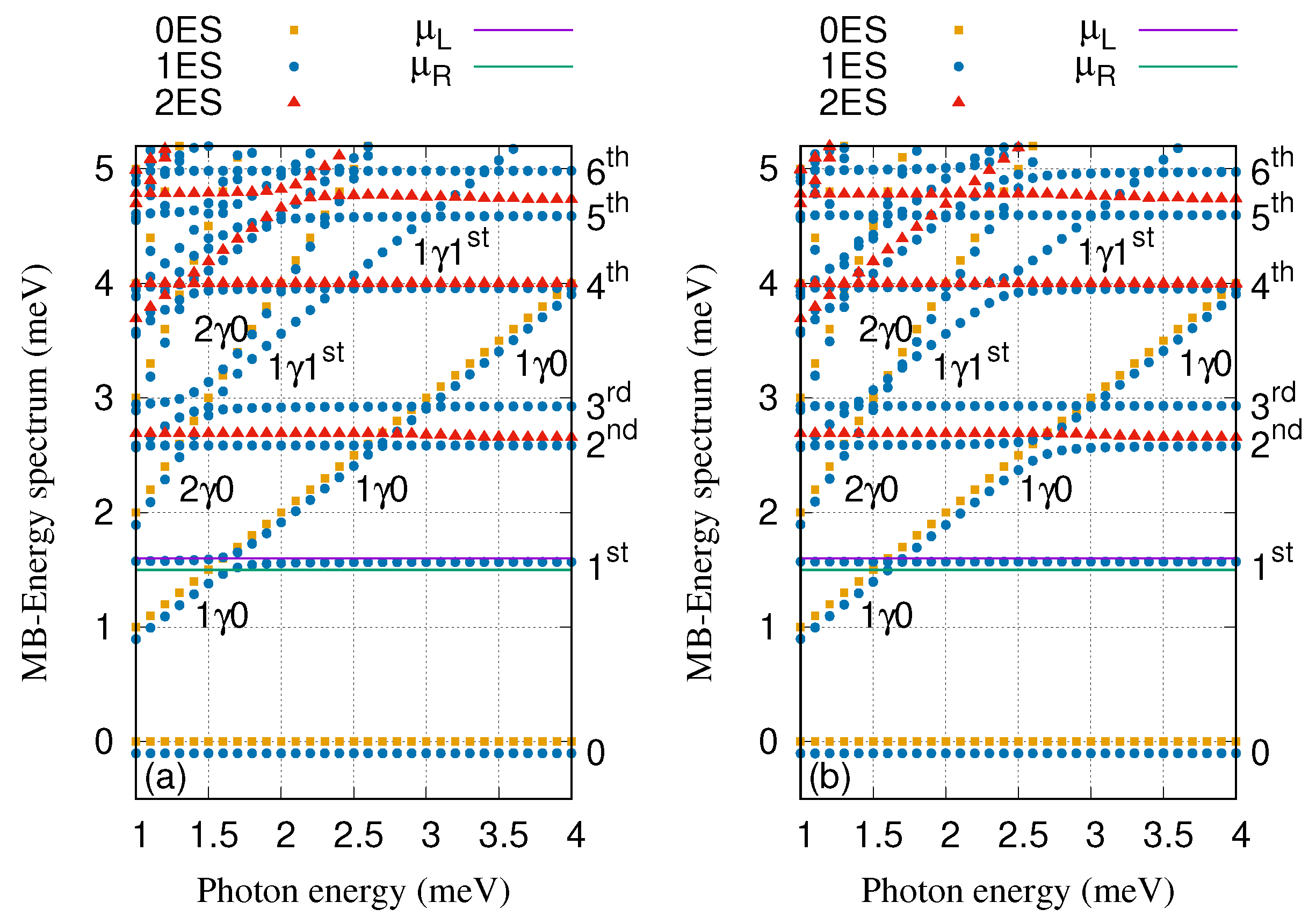
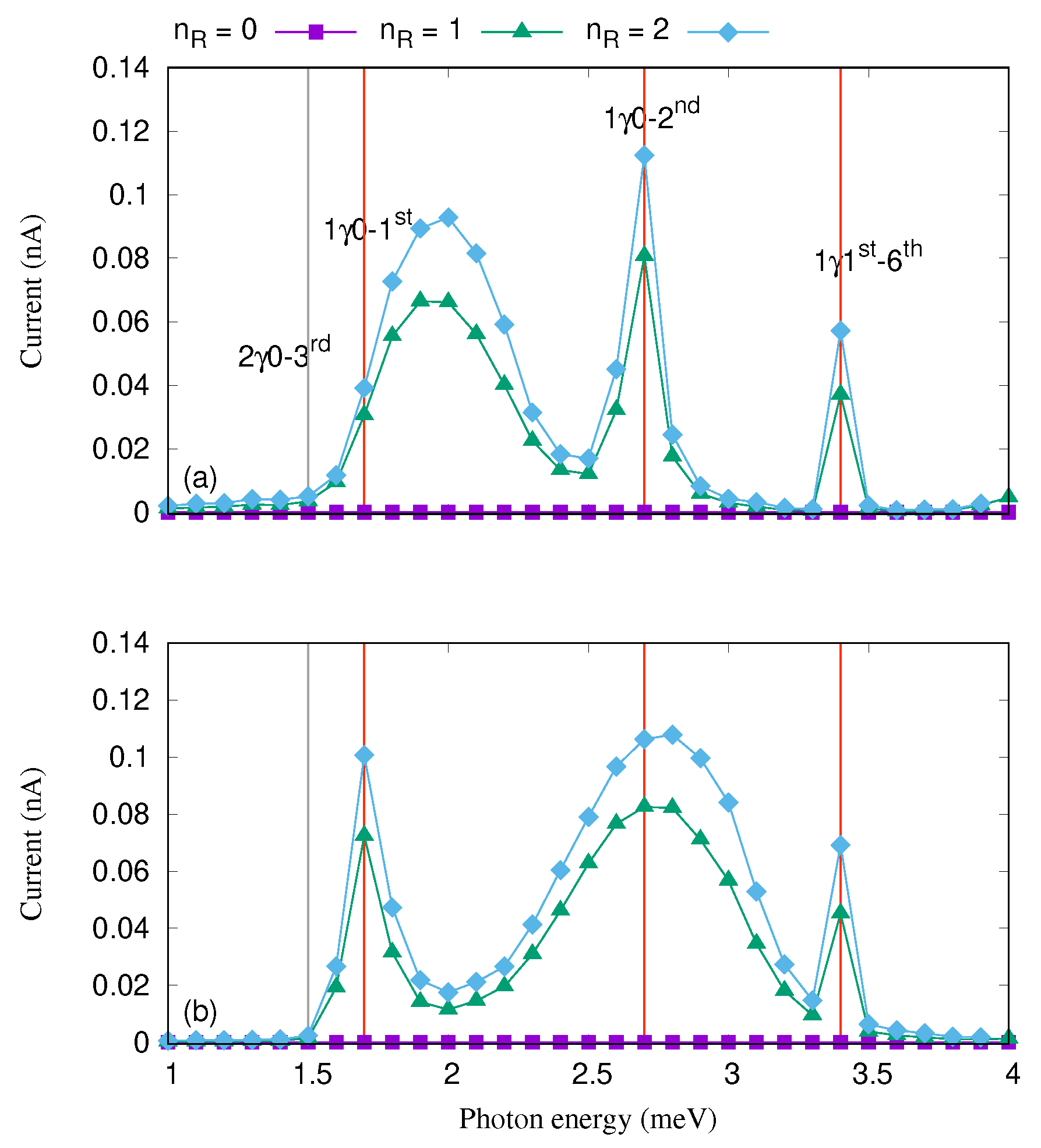
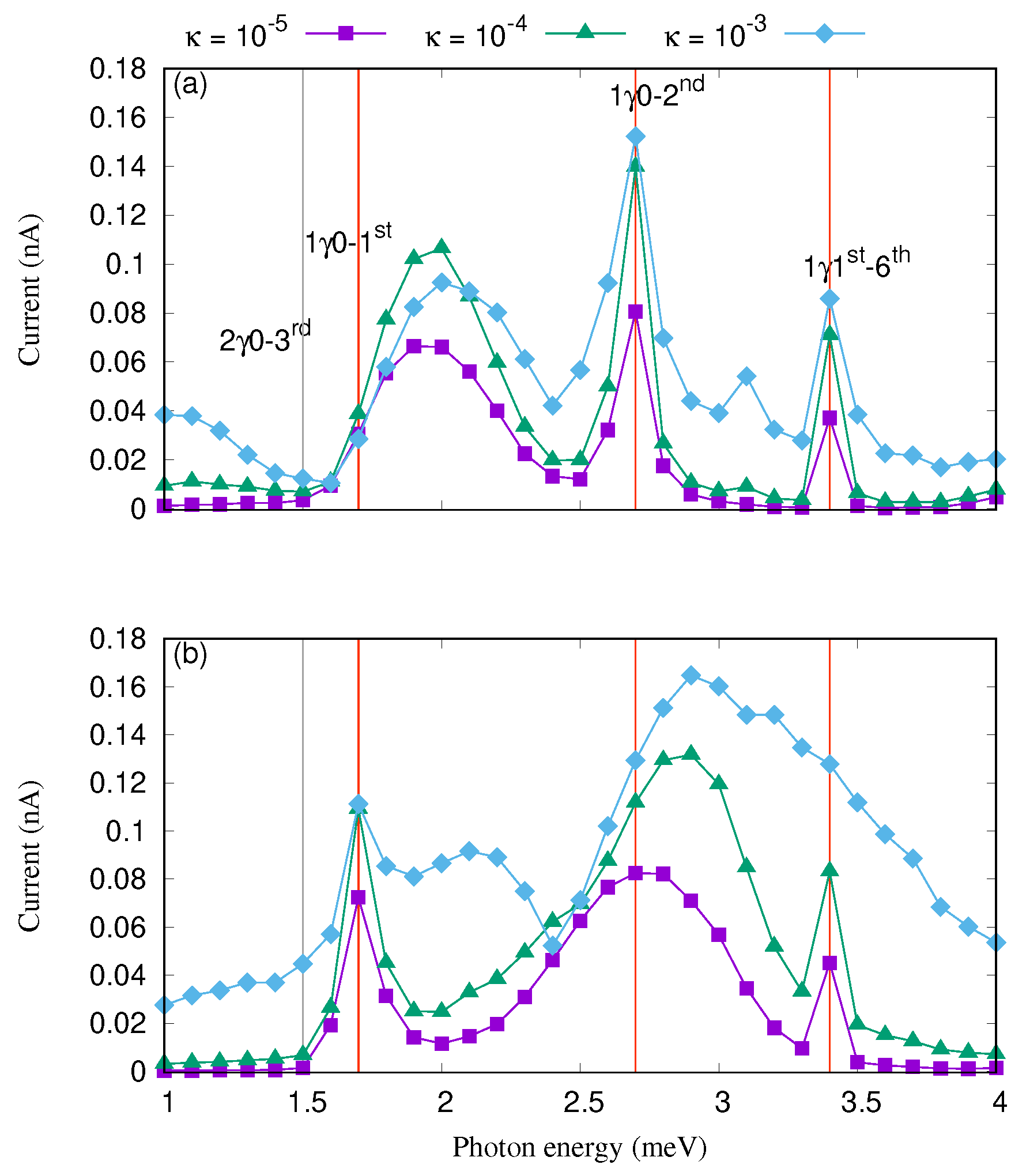
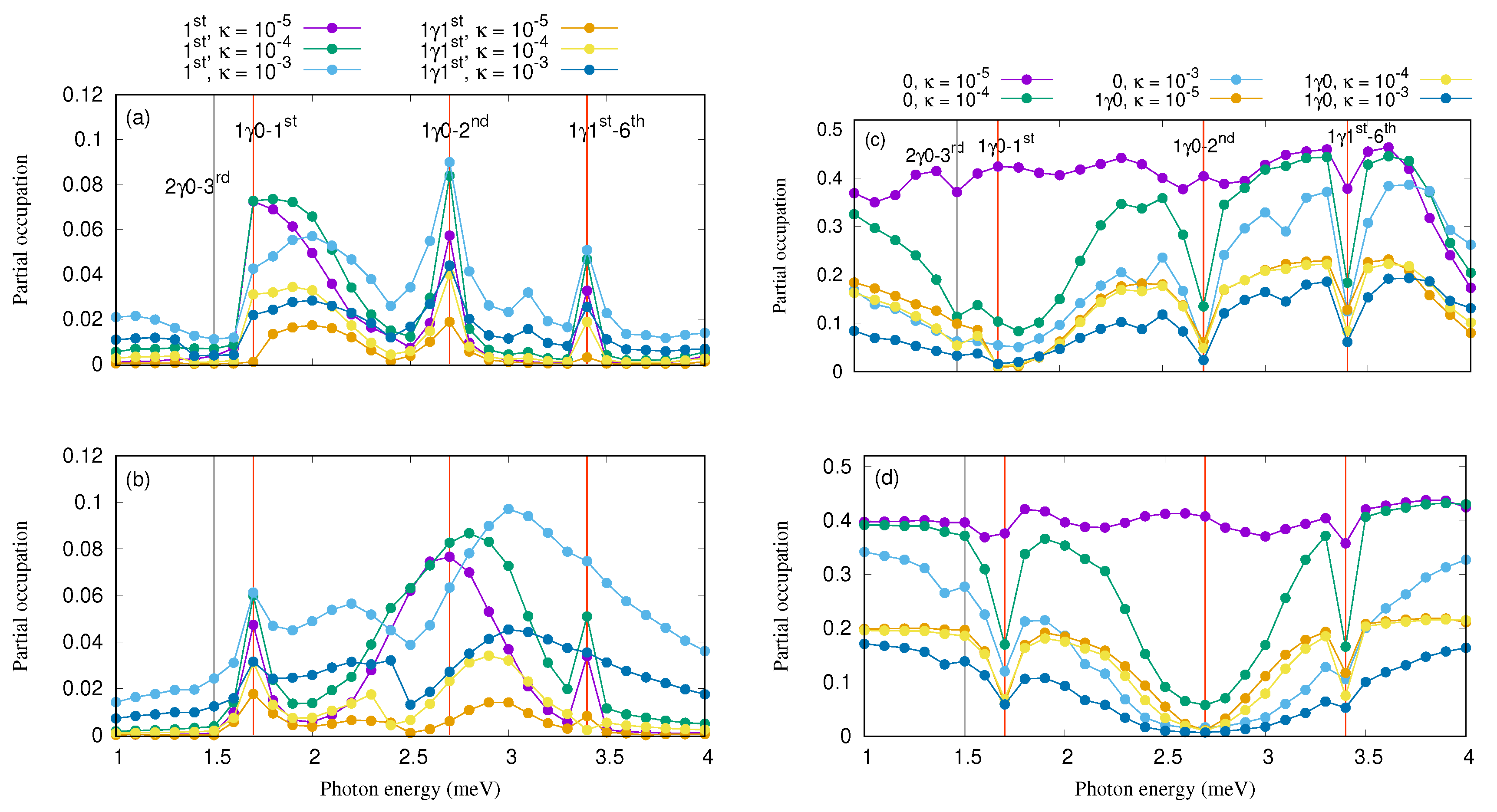
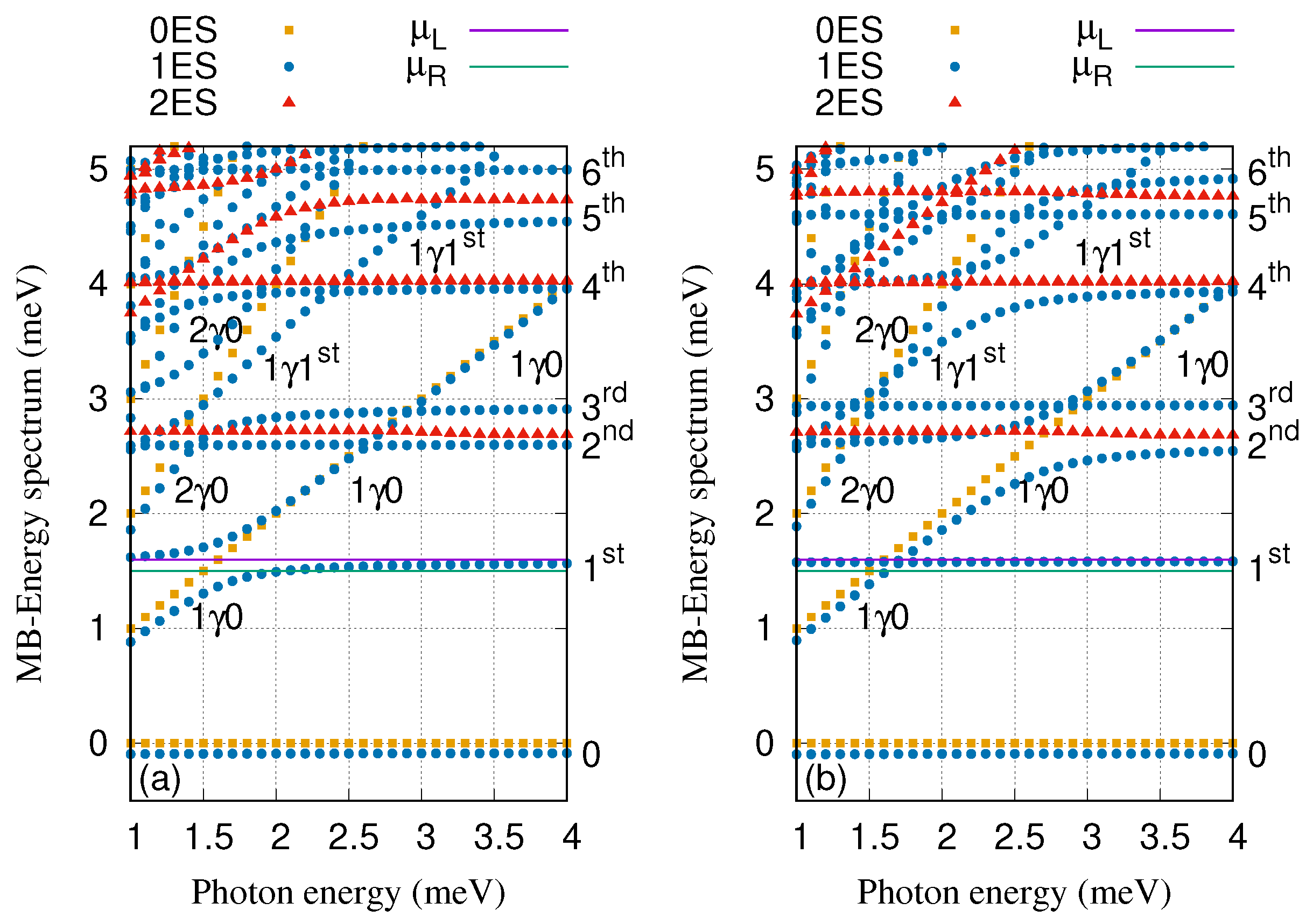
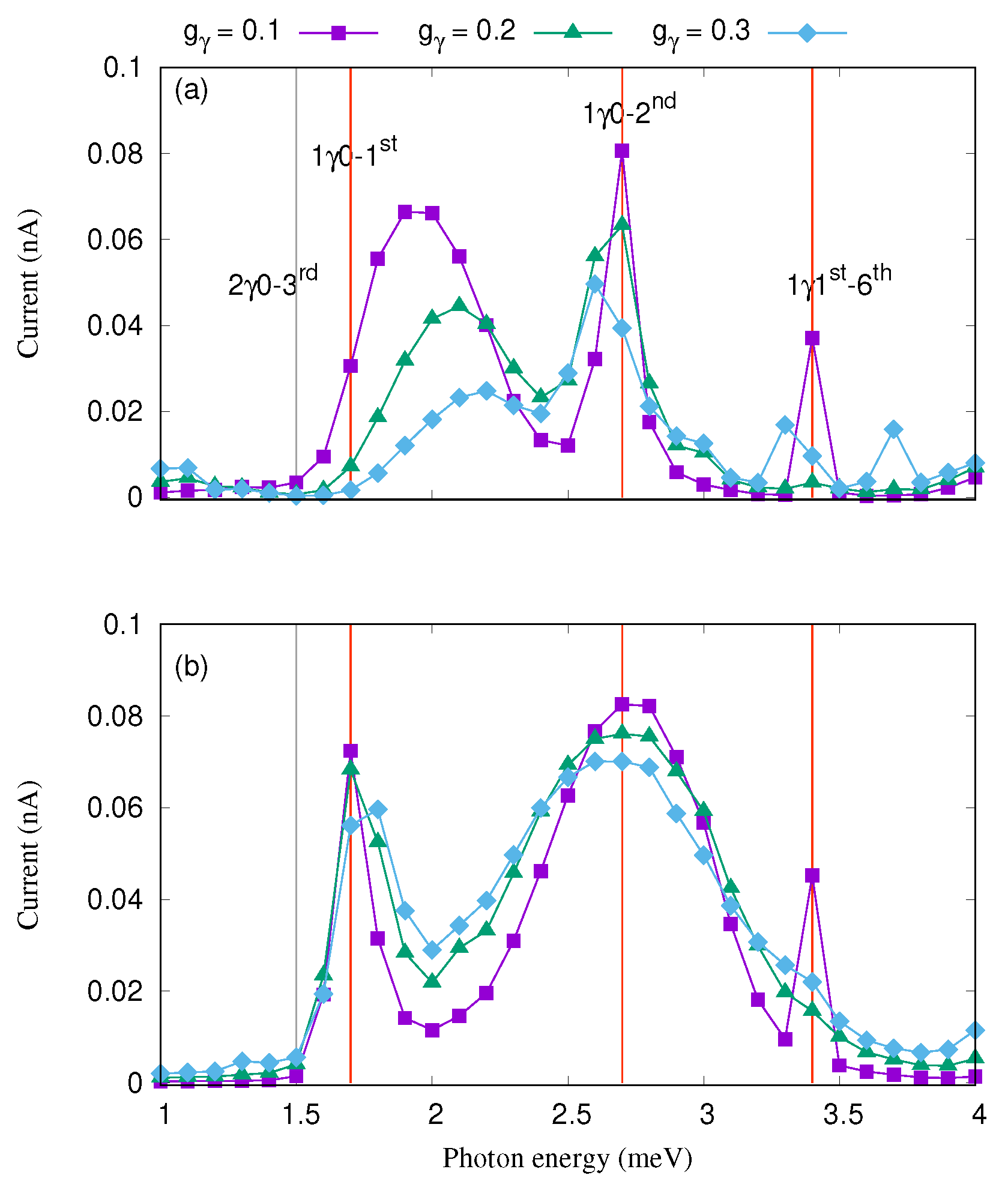
© 2019 by the authors. Licensee MDPI, Basel, Switzerland. This article is an open access article distributed under the terms and conditions of the Creative Commons Attribution (CC BY) license (http://creativecommons.org/licenses/by/4.0/).
Share and Cite
Abdullah, N.R.; Tang, C.-S.; Manolescu, A.; Gudmundsson, V. Manifestation of the Purcell Effect in Current Transport through a Dot–Cavity–QED System. Nanomaterials 2019, 9, 1023. https://doi.org/10.3390/nano9071023
Abdullah NR, Tang C-S, Manolescu A, Gudmundsson V. Manifestation of the Purcell Effect in Current Transport through a Dot–Cavity–QED System. Nanomaterials. 2019; 9(7):1023. https://doi.org/10.3390/nano9071023
Chicago/Turabian StyleAbdullah, Nzar Rauf, Chi-Shung Tang, Andrei Manolescu, and Vidar Gudmundsson. 2019. "Manifestation of the Purcell Effect in Current Transport through a Dot–Cavity–QED System" Nanomaterials 9, no. 7: 1023. https://doi.org/10.3390/nano9071023
APA StyleAbdullah, N. R., Tang, C.-S., Manolescu, A., & Gudmundsson, V. (2019). Manifestation of the Purcell Effect in Current Transport through a Dot–Cavity–QED System. Nanomaterials, 9(7), 1023. https://doi.org/10.3390/nano9071023




